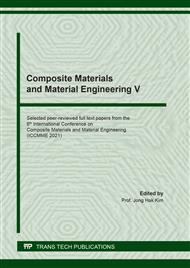p.85
p.91
p.98
p.107
p.112
p.123
p.129
p.135
p.147
Zinc Oxide-Based Pseudocapacitors with Electrospun Poly(Vinylidene Fluoride)/Poly(Ionic Liquid) Nanofibers as Solid Polymer Electrolyte
Abstract:
Due to the interesting properties of polymerized ionic liquids (PILs), studies are carried out to evaluate its performance when in composite with other synthetic polymers. Research on blend films prepared through solution casting are typically done to investigate their properties, however, electrospun fibers are of particular interest especially on technologies requiring mechanically robust and high surface area functional materials. In this work, poly (vinylidene fluoride)/poly (ionic liquid) (PVdF/PIL) nanofibers were produced through electrospinning. The PIL, poly (1-hexyl-3-vinyl imidazolium bromide), was synthesized through sonochemical solventless reaction followed by free radical polymerization. The structures of the synthesized IL and PIL were confirmed using FT-IR, 1H-NMR and 13C-NMR spectroscopy. Pseudocapacitor prototypes consisting of electrodeposited ZnO-based electrodes and the electrospun PVdF/PIL nanofibers as the polymer electrolyte were then fabricated at varied PIL concentrations. Contact angle measurements using sessile drop method revealed the decreasing wettability of the fibers attributed to the inherent hydrophobic nature of both the PVdF and PIL. Scanning electron micrographs also showed that increasing fiber diameters were obtained as the PIL concentration increases. In addition, cyclic voltammetry results showed that the calculated areal capacitance also increases with increasing PIL concentration. The development of pseudocapacitor assemblies utilizing ZnO-based electrodes and electrospun polymer electrolyte-separator membranes presents a better promise for the next-generation energy storage devices.
Info:
Periodical:
Pages:
112-119
Citation:
Online since:
June 2021
Price:
Сopyright:
© 2021 Trans Tech Publications Ltd. All Rights Reserved
Share:
Citation:


